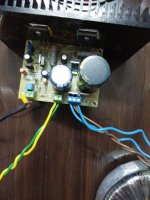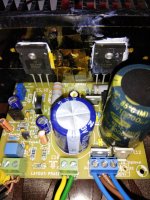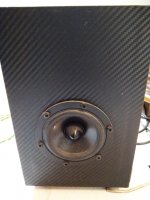Thanks for answer!
May be i must buy a smps when i will have the money. 😀
When....
May be i must buy a smps when i will have the money. 😀
When....
Last edited:
After a few hiccups, some good news..
I decided to give the board another run with the 1.6A 48V Sony SMPS tonight and it went well.
There is a 25KHz noise on the output shown on the 'scope but this is low amplitude so shouldn't be a problem.
Plugged in the test speaker (4 Ohm) for low power testing - there is an audible noise floor with no input connected. Definitely noticeable but I'll save that problem for later.
Played some music via my mobile phone and I have to say I was impressed by the clarity even through really terrible speakers and crocodile clips!
Once the enclosure arrives, I'll get it setup properly with shielded cables etc and give it a proper run with the 8 Ohm boxes.
😀
I decided to give the board another run with the 1.6A 48V Sony SMPS tonight and it went well.
There is a 25KHz noise on the output shown on the 'scope but this is low amplitude so shouldn't be a problem.
Plugged in the test speaker (4 Ohm) for low power testing - there is an audible noise floor with no input connected. Definitely noticeable but I'll save that problem for later.
Played some music via my mobile phone and I have to say I was impressed by the clarity even through really terrible speakers and crocodile clips!
Once the enclosure arrives, I'll get it setup properly with shielded cables etc and give it a proper run with the 8 Ohm boxes.
😀
Thanks for answer!
May be i must buy a smps when i will have the money. 😀
When....
apex has a diy version of smps if memory serves right🙂...dont know if sch and build details are available🙄...
If you intend to use this amp without preamp with just 10k log pot at the input I suggest not to change the gain from the schematic. It works just fine.
Hi Ivan,
I reduced the gain on the amp purely on the simulated distortion being reduced by doing so. I intend to try 3.6k, 4.7k and the schematic 6.8k in R6 and see how it sounds for each.
I tried it out tonight with my mobile phone and 3.6k in R6 and it was sufficiently powered to get a feel for the sound without turning the phone volume up past 66%.
apex has a diy version of smps if memory serves right🙂...dont know if sch and build details are available🙄...
Yes i know but the problem is the transformer. I think that i can't do it by myself.
Yes i know but the problem is the transformer. I think that i can't do it by myself.
Yes you can do it by yourself, use ETD49 core N97 material, wind 4 turns with 1,5mm wire for 50V secundar, turn 2-3m kapton tape for isolation and 12 turns with 1mm wire for primar...
Hi all,
Success!!. It fired up without any trouble.
Transformer , a big hefty 400VA 2x 35VAC that I had.
On - board PSU used consisting of 2 rectifier diodes and 10kuF cap.
PSU voltage 53.7 V
Mid-point voltage - 27.6V
no hum or hiss or any kind., transistors and zobel cool.
bias set to 15mV across 0.33R emitter, so bias current is =45mA.
Sound: very nice, relaxed sound, although caps haven't been broken-in and only a single channel. Still using ordinary caps. When building stereo, I intend use good ones I have. Test speaker is a full ranger with Dayton reference series RS100-8, 4" in a 3.2 liter box, that was gathering dust (you can see😉)
It seems on board PSU is sufficient to get a good sound without any hum. SO two channels of these and a transformer would make a compact amplifier with some other hardware like chassis and connectors thrown in.
attached: some pics and sound recorded thro mobile phone, so not good quality.
regards
Prasi
edit: o/p device MJL21194. pic shows how the bias diodes mounted to heatsink with kapton tape, forgot to put in heatsink blob. will do it with stereo build.
Success!!. It fired up without any trouble.
Transformer , a big hefty 400VA 2x 35VAC that I had.
On - board PSU used consisting of 2 rectifier diodes and 10kuF cap.
PSU voltage 53.7 V
Mid-point voltage - 27.6V
no hum or hiss or any kind., transistors and zobel cool.
bias set to 15mV across 0.33R emitter, so bias current is =45mA.
Sound: very nice, relaxed sound, although caps haven't been broken-in and only a single channel. Still using ordinary caps. When building stereo, I intend use good ones I have. Test speaker is a full ranger with Dayton reference series RS100-8, 4" in a 3.2 liter box, that was gathering dust (you can see😉)
It seems on board PSU is sufficient to get a good sound without any hum. SO two channels of these and a transformer would make a compact amplifier with some other hardware like chassis and connectors thrown in.
attached: some pics and sound recorded thro mobile phone, so not good quality.
regards
Prasi
edit: o/p device MJL21194. pic shows how the bias diodes mounted to heatsink with kapton tape, forgot to put in heatsink blob. will do it with stereo build.
Attachments
Last edited:
hi thimios,
I used MJE15032/33 combo, which also works perfect in sim with cordell models.
regards
Prasi
I used MJE15032/33 combo, which also works perfect in sim with cordell models.
regards
Prasi
Congratulations Prasi and Avtech, great progress all round. I think this is a very nice amplifier, that will quickly replace my chip amp.
Thank you Prasi for the awesome little PCB🙂
Thank you Prasi for the awesome little PCB🙂
Looks good Prasi! +1 thanks for the pcb design.
Is there a difference in using 0.33r instead of the 0.47r?
Is your board totally silent with no input connected?
Is there a difference in using 0.33r instead of the 0.47r?
Is your board totally silent with no input connected?
I'm thinking my noise is from the SMPS.
Wondering if I should tie the negative output of the SMPS to chassis ground so it isn't floating. Not sure how that would make a difference though or if that's a good idea.
Wondering if I should tie the negative output of the SMPS to chassis ground so it isn't floating. Not sure how that would make a difference though or if that's a good idea.
Thanks guys,
yes, mine is dead silent either with no i/p connected and with i/p connected but not playing.
I dont think there is any difference in using 0.33R vs 0.47R, higher value could only help a tiny bit with bias stability.
I dont think negative of smps connection to chassis would help. Some other forum members might be able to tell which SMPS are good and have been used for audio w/o problems.
regards
Prasi
yes, mine is dead silent either with no i/p connected and with i/p connected but not playing.
I dont think there is any difference in using 0.33R vs 0.47R, higher value could only help a tiny bit with bias stability.
I dont think negative of smps connection to chassis would help. Some other forum members might be able to tell which SMPS are good and have been used for audio w/o problems.
regards
Prasi
Sadly there is no comeback as we accept their terms and conditions.
I rang them up to tell them their parts bin was wrong but all they would do was apologise.
I feel very lucky (and surprised).
E14 have agreed to not only supply the correct transistor, but also replace the outputs and the other driver.
Some other forum members might be able to tell which SMPS are good and have been used for audio w/o problems.
I read an article that suggested that the SMPS might go into PWM mode at low current draw to be more efficient.
I'll re-evaluate once the chassis turns up and I get everything tidied away.
Hi Prasi,
Good to know that the circuit is noiseless with ordinary onboard supply. In that case I am thinking to populate empty places on board and use ordinary suuply.
Good to know that the circuit is noiseless with ordinary onboard supply. In that case I am thinking to populate empty places on board and use ordinary suuply.
Hello Ivan,
As I mentioned I used a speaker with Dayton reference series RS100-8, which isnt super sensitive driver at 84.6dB.
I have another computer speaker thats quite sensitive, lets see if that brings up any hum issues to light.
I continued my listening for 2-3 hours into the night yesterday, have to say there is no need for tone control / bass adjustment. Its a pleasure to listen to. Thanks Mr. Mile for the circuit.
once built in stereo with good caps and a bit of break-in, I will put it on my floorstanders that go pretty deep. That would be a good test.
regards
Prasi
As I mentioned I used a speaker with Dayton reference series RS100-8, which isnt super sensitive driver at 84.6dB.
I have another computer speaker thats quite sensitive, lets see if that brings up any hum issues to light.
I continued my listening for 2-3 hours into the night yesterday, have to say there is no need for tone control / bass adjustment. Its a pleasure to listen to. Thanks Mr. Mile for the circuit.
once built in stereo with good caps and a bit of break-in, I will put it on my floorstanders that go pretty deep. That would be a good test.
regards
Prasi
Last edited:
Prasi,
I know that Danish loudspeaker drivers manufacturer Peerless has factory in India. Is there an mail order company in India that sells Peerless drivers produced in India?
I know that Danish loudspeaker drivers manufacturer Peerless has factory in India. Is there an mail order company in India that sells Peerless drivers produced in India?
Yes, the factory is in Mumbai.
They still produce Peerless drivers. XLS Encore kit from GR-Research is based on Peerless drivers produced in India.
But somehow the general market availability of peerless drivers seems to have gone down in India.
diyaudiocart still has some drivers left.
My floorstandrs are based on their 6.5" woofer and a very good 1" silk dome tweeter.
They still produce Peerless drivers. XLS Encore kit from GR-Research is based on Peerless drivers produced in India.
But somehow the general market availability of peerless drivers seems to have gone down in India.
diyaudiocart still has some drivers left.
My floorstandrs are based on their 6.5" woofer and a very good 1" silk dome tweeter.
- Home
- Amplifiers
- Solid State
- Retro Amp 50W Single Supply


